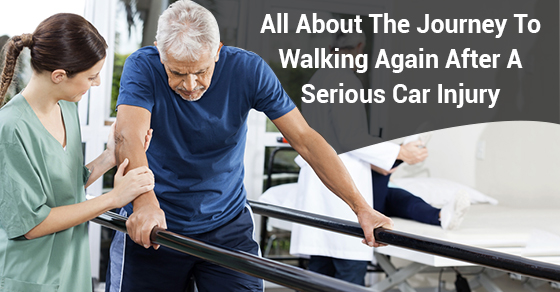Physical therapy is a group of interventions designed to improve range of motion, strengthen muscles and joints, restore mobility and endurance and provide patients with medical-grade equipment and assistive devices. Following a serious car injury, patients work with physiotherapists to recover and learn to walk again. The journey from dealing with the immobile state that you’re left in after a car crash to walking again can be long and arduous. However, if you work with a registered physiotherapist, that uphill journey will get you back to your pre-accident self and walking with confidence. Continue reading to learn more about walking after serious injury.
Rehabilitation: The therapy process after a car accident
In the days following a car accident, you will probably be hospitalized. The amount of time you spend in the hospital will depend on how severe your injuries are. Once you are released from the hospital’s care, you will visit a physiotherapy clinic. At the clinic you’ll be paired with a team of healthcare professionals and physiotherapists who will be in charge of administering your rehabilitation program.
Research proves that soft tissues heal faster through movement. You may be tempted to rest to avoid aggravating your injuries; however, this is not a good idea. The physical therapy program that is created for you will ensure that you get enough rest between exercises.
Your treatment can include the following:
-
- Passive exercise: When you cannot move your limbs by yourself, your therapist will move them for you. This allows for better circulation and keeps your limbs from atrophying.
- Gait training: This involves showing you how to physically put one foot in front of the other. Following a car accident that leaves you with no mobility in your lower limbs, you will need to retrain your body on how to move. Your therapist will study your legs and hips to ensure your post-accident gait is strong and there is no chance of re-injuring yourself with every step.
- Balance and coordination exercises: In order to stabilize you when you stand up for the first time after your car accident, you’ll need to work on your balance. Using equipment like parallel bars, you will have your therapist stand behind you while you swing your legs in a walking motion. As for coordination, these exercises involve repetition of movement so that your body begins to remember how to take steps. Repetition is also a great exercise for people who have sustained a concussion after an accident, especially if memory loss occurs, because it helps the brain get back to normal.
- Neuromuscular reeducation: Your muscles need a refresher course too which is what neuromuscular reeducation is. Using specific techniques, any inactive muscle groups that are used for walking will learn to become active again.
- Learning to use adaptive devices: When you start to become mobile again, you may require a cane, brace, walker, crutches or splint. These are adaptive devices that allow you to walk with assistance. Your physiotherapist will show you the proper way to walk with these devices so that you aren’t using the wrong muscle groups and putting too much stress on your joints.
- Muscle-strengthening exercises: These are a group of exercises designed to increase the resistance and strength of muscles that have been weakened from the accident.
- Range of motion exercises: These entail you moving your joints beyond the point of pain. The motion is increased each time and is combined with moderate stretching so you don’t feel pain once the motion has stopped.
- Extra therapies: Your rehabilitation program will also include massage therapy, acupuncture, chiropractic services, muscle stimulation, laser therapy and pelvic floor retraining if necessary. These services complement the physical aspect of your recovery.
- Dealing with trauma: After a car accident, you may be scared to ride or drive a vehicle again. To help you get over this trauma, you will work with a counsellor or psychologist to equip you with the mental strength to get back behind the wheel.
Ambulation: The final step
After you have undergone the aforementioned physical therapy, you’ll move on to the last step in your recovery, which is walking. Ambulation exercises are designed to get you walking without assistance. You will need to re-learn how to climb up and down stairs, step over curbs and walk on uneven surfaces like pavement.
Timeline: How long does the journey to recovery take?
Every patient responds to physiotherapy differently, so it’s hard to pinpoint the exact length of each journey. The severity of injuries following a car accident can also determine how long you will need to work with a physiotherapist. At Focus Physiotherapy, our rehabilitation programs are tailored to the individual, and we also work to keep you from re-injuring yourself.
If you or a loved one is looking for a trusted physiotherapy clinic after a car accident, please do not hesitate to contact us. We will get you back on your feet, regardless of your injuries.

